Chapter 22.26
SIGN REGULATIONS
Sections:
22.26.002 Applicability and interpretation.
22.26.003 Application procedures.
22.26.004 Permit requirements and approval authority.
22.26.005 Submittal requirements.
22.26.008 Nonconforming signs.
22.26.009 Maintenance, renewal and enforcement.
22.26.010 Classification and regulation of signs.
22.26.011 Sign standards applicable to all signs.
22.26.012 Illumination standards.
22.26.014 Awning, canopy and marquee signs.
22.26.015 Changeable copy sign.
22.26.020 Service island signs.
22.26.001 Intent and purpose.
(a) Intent. Signs have a strong visual impact on the character and quality of the community. As a prominent part of the scenery, they attract or repel the viewing public and affect the safety of motorists, cyclists and pedestrians. Their suitability or appropriateness helps to set the tone for a neighborhood. The city relies upon its scenery and physical beauty to attract commerce; aesthetic considerations assume economic value. It is the intent of the city, through this chapter, to protect and enhance the city’s historic and residential character and its economic base through the provision of appropriate and aesthetic signage. In addition, it is the intent of the city to regulate the size, type and location of signs in order to minimize their distracting effect on drivers and thereby improve traffic and enhance pedestrian and cyclist safety.
(b) Purpose. The purpose of this chapter is to promote the public health, safety and welfare through a comprehensive system of reasonable, effective, consistent, content-neutral and nondiscriminatory sign standards and requirements. This chapter has also been adopted to:
(1) Promote and accomplish the goals, policies and objectives of the city’s comprehensive plan and land development code;
(2) Provide minimum standards in order to safeguard life, health, property and public welfare, and promote traffic safety by controlling the design, quality of materials, construction, illumination, size, location and maintenance of sign and sign structures;
(3) Recognize free speech rights by regulating signs in a content-neutral manner;
(4) Promote the free flow of traffic and protect pedestrians, cyclists and motorists from injury and property damage caused by, or which may be fully or partially attributable to, cluttered, distracting and/or illegible signage;
(5) Protect the beauty of the city’s built environment by encouraging signs that are compatible with the architectural style, characteristics and scale of the building to which it may be attached, and to encourage signs that are compatible with adjacent buildings and businesses;
(6) Protect property values, the local economy, and the quality of life by preserving and enhancing the appearance of the streetscape;
(7) Provide consistent sign design standards;
(8) Encourage creative and innovative approaches to signage, and signs that are of a quality design, pleasing in appearance and appropriate in size, materials and illumination to the surrounding neighborhood;
(9) Provide an improved visual environment for the citizens of and visitors to the city; and
(10) Adopt clear, understandable regulations that enable the fair and consistent enforcement of this chapter. (Ord. 1598 § 1, 2017; Ord. 1322 § 1, 2003).
22.26.002 Applicability and interpretation.
This chapter applies to all signs as defined in Chapter 22.98 FMC, within the city that are visible from any street, sidewalk or public place, regardless of the type or nature.
This chapter is not intended to, and shall not be interpreted to, restrict speech on the basis of its content, viewpoint, or message. Any classification of signs in this chapter that purports to permit speech by reason of the type of sign, identity of the sign user or otherwise, shall be interpreted to allow commercial or noncommercial speech on the sign. No part of this chapter shall be construed to favor commercial speech over noncommercial speech. To the extent that any provision of this chapter is ambiguous, the term shall be interpreted not to regulate speech on the basis of the content of the message. (Ord. 1598 § 2, 2017; Ord. 1473 § 1, 2009; Ord. 1322 § 1, 2003).
22.26.003 Application procedures.
Sign permit review is classified as a Type II-A application. The processing procedures for this type of application are described in Chapters 22.05, 22.06, 22.07, 22.08, 22.09 and 22.10 FMC. (Ord. 1598 § 3, 2017; Ord. 1322 § 1, 2003).
22.26.004 Permit requirements and approval authority.
(a) No sign shall hereafter be erected, reerected, constructed, altered, or maintained, except as provided by this chapter. A sign permit shall be obtained prior to any sign being erected, reerected, constructed, or altered, unless said sign is exempt from the permit requirements of this chapter pursuant to FMC 22.26.025. In addition, a building permit shall be obtained prior to the installation or modification of any sign for which a building permit is required under the International Building Code. A separate permit shall be required for each nonexempt sign installed, except if a sign is part of a group of signs being installed at one time on a single supporting structure, only one permit shall be required.
(b) The director may approve, approve with conditions, modify and approve with conditions, or deny an application for a sign permit. A sign permit shall be approved when the director has determined that a proposed sign will comply with all requirements of this chapter and, when applicable, the requirements of the International Building Code.
(c) Duration of a Sign Permit. In the event that a sign permit has not been exercised and the operations authorized under the sign permit have not been completed or substantially completed within 180 days after the date of the permit, the sign permit shall be automatically null and void.
(d) Interpretation. In all applications for sign permits where a matter of interpretation arises, the most restrictive definition shall prevail. (Ord. 1598 § 4, 2017; Ord. 1473 § 2, 2009; Ord. 1322 § 1, 2003).
22.26.005 Submittal requirements.
Application for a sign permit shall be submitted on forms provided by the department with the following items:
(a) Two copies of a scaled site plan showing the location of the affected lot, building(s) and sign(s);
(b) Two copies of a scaled drawing of the proposed sign or sign revision showing dimensions, area, height, structural footing details, method of attachment, type of illumination, and other construction details;
(c) Two copies of supporting documentation including material specifications, calculation for dead load and wind pressure, photographs or photo simulations of site and building marked to show where sign is proposed, and any other information required by the director to ensure compliance with applicable code requirements;
(d) Written consent of the sign owner and the owner of the building, structure, or property where the sign is to be erected;
(e) A nonrefundable filing fee in accordance with the planning services fee schedule established by council resolution;
(f) Documentation demonstrating that the sign installer has a valid Washington State contractor’s license when a sign requires a building permit, unless the sign is being installed by the owner of the sign.
The director may waive submission of specific plans, specifications or supporting documentation when such information is not necessary to determine compliance with applicable code requirements. (Ord. 1598 § 5, 2017; Ord. 1322 § 1, 2003).
22.26.006 Master sign plans.
(a) Before a sign permit may be issued for any commercial multi-tenant building constructed after the effective date of this chapter, or for any existing multi-tenant building whose exterior will be altered to the degree that existing signage will be replaced, a master sign plan shall be submitted to, and approved by, the city. Master sign plans shall be approved through the site plan review, development plan review, or conditional use permit process, as appropriate. Existing multi-tenant buildings may have master sign plans approved by the director in order to simplify the permitting process for individual signs at a later date. Individual buildings located within a multi-building complex may have separate master sign plans.
(b) Master sign plans shall indicate the amount, location, and type of signage allocated to each tenant space. The number of sign types, such as awning signs, cabinet signs, individual graphics, pan-channel sign graphics, sandblasted or carved wood signs, flat wood signs with hand painted or vinyl graphics, and neon signs, shall be limited to ensure visual continuity from one tenant space to the next within a building. If more than one sign type is used on a single building, the sign types shall have at least two of the following design elements in common with each other:
(1) Common colors on the background or text;
(2) Common lettering style;
(3) Common size (e.g., a specified height common to each sign); or
(4) Common materials.
(c) Criteria for Approval. All signs in the master sign plan must comply with FMC 22.26.004 and meet the following criteria:
(1) Signs shall be architecturally similar and visually related to each other through the incorporation of common design elements. Up to two sign types may be used on any one building. All sign cabinets, trim caps and all sign supports such as poles and braces shall be of a common color;
(2) Signs shall be architecturally integrated with the buildings included in the master sign plan; and
(3) Signs must not obscure the view of other signs that are consistent with this chapter. (Ord. 1598 § 6, 2017; Ord. 1322 § 1, 2003).
22.26.007 Variances.
(a) Approval Required. A variance may be granted from the strict application of the regulations in this chapter that apply to: (1) sign placement on a parcel or building frontage; (2) sign area; or (3) sign height, as regulated in this chapter. A variance may not be granted to allow any prohibited signs as described in FMC 22.26.026, or prohibited sign features, as described elsewhere in this chapter, or for any other purpose not listed in this subsection.
(b) Need for Sign Permit, Consolidation of Processing. A sign variance application may be submitted before or concurrent with the associated sign permit application. No sign permit application requiring a variance for issuance will be processed without a sign variance.
(c) A sign variance is classified as a Type III application. The processing procedures for this type of application are described in Chapters 22.05, 22.06, 22.07, 22.08, 22.09 and 22.10 FMC. In addition, a variance requested from any requirement in this chapter shall be processed in accordance with Chapter 22.74 FMC, except that the criteria for variance approval listed in FMC 22.74.003 shall not be used to determine whether a variance may be granted. Instead, a variance may only be approved if all of the following criteria are satisfied:
(1) The request for a sign variance is due to unusual conditions pertaining to sign visibility needs for a specific building or lot;
(2) The sign will be in keeping with the general character of the surrounding area;
(3) The sign will not create a hazard;
(4) The granting of the variance would not be materially detrimental to the property owners in the vicinity;
(5) The variance sought is of minimum sign size, height, and scope to meet the conditions and needs of the applicant;
(6) The granting of the variance would not be contrary to the objectives of the comprehensive plan; this title, Land Development; and this chapter;
(7) The signage of the property in question cannot be adequately met under the literal interpretation and strict application of the chapter; and
(8) The granting of the variance is necessary because of special circumstances relating to the property location, topography, shape and size, sight distance and limited view to property.
(d) First Amendment Exception/Variance. Where an applicant can demonstrate that the strict application of the regulations in this chapter would violate his/her First Amendment rights, the city may grant a variance that does not conform to all of the variance criteria in subsection (c) of this section. However, the applicant shall submit an application that provides his/her response to each of the variance criteria in subsection (c) of this section. The city need not make findings that all of the variance criteria have been satisfied, but if not all criteria have been satisfied, the variance may only be granted to the extent reasonably necessary to protect the applicant’s First Amendment rights. If a First Amendment exception is granted, it shall be treated as an approval of a variance for purposes of this chapter. (Ord. 1598 § 7, 2017; Ord. 1322 § 1, 2003).
22.26.008 Nonconforming signs.
(a) Except for temporary signs, as defined herein, signs legally established prior to the adoption of this chapter that do not conform with the regulations provided herein with regard to type, number, size, height, illumination, location or other characteristics shall be allowed to remain as legal nonconforming signs until the sign is removed, moved or structurally or electrically changed, except such signs must be brought into conformance with this chapter:
(1) When a building, tenant space, or property containing a legal nonconforming sign is enlarged or remodeled to a value of 25 percent or more of existing assessed valuation of real property improvements;
(2) When the use of a building, tenant space or property containing a legal nonconforming sign changes from one type of business or other tenancy to another type of business or other tenancy;
(3) When a building or property containing a legal nonconforming sign is vacated for a period exceeding 90 days; or
(4) When an existing business containing a legal nonconforming sign changes ownership. Monument signs and wall signs legally established subsequent to the effective date of Ordinance 1322 (February 5, 2003) are exempt from this requirement.
(b) Nonconforming multi-tenant signs located in a multi-tenant center are not required to be brought into conformance with this chapter per subsection (a) of this section until:
(1) The multi-tenant center is enlarged or remodeled to a value of 25 percent or more of existing assessed valuation of real property improvements;
(2) The multi-tenant center or multi-tenant sign is vacated for a period exceeding 90 days; or
(3) The property changes ownership. Monument signs and wall signs legally established subsequent to the effective date of Ordinance 1322 (February 5, 2003) are exempt from this requirement.
(c) In such cases where a nonconforming sign is moved or changed, the sign shall be treated as a new sign and subject to the requirements of this chapter. Changes to a sign face (e.g., a change in advertising copy) may be made to a nonconforming sign; provided, that such changes conform to this chapter in terms of colors, graphics, materials, illumination and other applicable standards. A sign permit for such changes must be obtained.
(d) Temporary signs, that do not conform with the regulations provided herein with regard to type, number, size, height, illumination, or location of signs, shall be brought into conformance with all applicable standards no later than 90 days from the effective date of the ordinance codified in this chapter. (Ord. 1598 § 8, 2017; Ord. 1490 § 1, 2009; Ord. 1322 § 1, 2003).
22.26.009 Maintenance, renewal and enforcement.
(a) Maintenance. It is unlawful for any owner of record, lessor, lessee, manager or other person having lawful possession or control over a building, structure or parcel of land to fail to maintain any signs on the building, structure or parcel in compliance with this chapter.
(1) Sign Maintenance. All signs, whether or not in existence prior to adoption of this chapter, shall be maintained. Maintenance of a sign shall include periodic cleaning, replacement of flickering, burned out or broken light bulbs or fixtures, repair or replacement of any faded, peeled, cracked or otherwise damaged or broken parts of a sign, and any other activity necessary to restore the sign so that it continues to comply with the requirements and contents of the sign permit issued for its installation and provisions of this chapter.
(2) Landscape Maintenance. Required landscaped areas contained by a fixed border, curbed area or other perimeter structure shall receive regular repair and maintenance. Plant materials that do not survive after installation in required landscape areas are required to be replaced within six months of the plant’s demise or within the next planting season, whichever event first occurs.
(b) Removal. Any vacant and/or unused sign support structures, angle irons, sign poles or other remnants of signs that are currently not in use, or are not proposed for immediate reuse by a sign permit application for a permitted sign, shall be removed. In addition to the remedies in Chapter 22.95 FMC, the director shall have the authority to require the repair, maintenance or removal of any sign or sign structure that has become dilapidated or represents a hazard to the safety, health or welfare of the public, at the cost of the sign and/or property owner.
(c) Enforcement. Violations of the provisions of this chapter shall be enforced according to Chapter 22.95 FMC. (Ord. 1598 § 9, 2017; Ord. 1473 § 3, 2009; Ord. 1322 § 1, 2003).
22.26.010 Classification and regulation of signs.
(a) Classification. Signs may be classified in the following general categories:
(1) Accessory signs;
(2) Awning, canopy, and marquee signs;
(3) Changeable copy signs;
(4) Digital signs;
(5) Freestanding signs;
(6) Portable signs;
(7) Projecting signs;
(8) Service island signs;
(9) Temporary signs;
(10) Under-canopy signs;
(11) Wall signs; or
(12) Window signs.
(b) Regulation. No classification of sign shall be permitted to be constructed, erected or placed on any property unless it is listed as a permitted sign within the sign group applicable to the subject property as set forth in subsection (c) of this section or listed as an exemption in FMC 22.26.025.
(c) Sign Groups. For purposes of this regulation, the various sign groups are established as follows:
(1) Group 1. Properties located within a PROS, GC, or other nonresidential or noncommercial zoning classification; properties located within an R-4, R-4-C, R-6, R-8, R-10-TCD, R-20, R-30, or other residential zoning classification established subsequent to adoption of this chapter that are developed for nonresidential uses such as schools, churches, parks and municipal buildings or facilities;
(2) Group 2. Residentially developed properties located within an R-4, R-4-C, R-6, R-8, R-10-TCD, R-20, R-30, or other residential zoning classification established subsequent to adoption of this chapter; and
(3) Group 3. Properties located within an NO, NC, MUN, MUU, or other commercial or mixed-use zoning classification established subsequent to adoption of this chapter.
(d) Table 1 identifies the permitted types of signs by sign group. An “X” in the table indicates that the particular type of sign is allowed in a sign group. See applicable standards in the section noted for each sign type for specific requirements and for possible exceptions to the provisions below.
|
|
Sign Group |
||
|---|---|---|---|
|
Sign Type |
Group 1 |
Group 2 |
Group 3 |
|
Accessory |
X1 |
|
X |
|
Awning, canopy and marquee |
X |
|
X |
|
Changeable copy |
X |
|
X |
|
Digital |
X |
|
X |
|
Freestanding |
X |
|
X |
|
Portable |
X |
X2 |
X |
|
Projecting |
|
|
X |
|
Service island |
|
|
X |
|
Temporary |
X |
X |
X |
|
Under-canopy |
|
|
X |
|
Wall |
X |
X |
X |
|
Window |
X |
X2 |
X |
1 Excluding large accessory signs
2 Temporary only
(Ord. 1667 § 4, 2020; Ord. 1598 § 10, 2017; Ord. 1490 § 2, 2009; Ord. 1322 § 1, 2003).
22.26.011 Sign standards applicable to all signs.
(a) Sign Area. Sign area for all sign types is measured as follows:
(1) Background Panel or Surface. Sign copy mounted, affixed or painted on a background panel or surface distinctively painted, textured or constructed as a background for the sign copy is measured as that area contained within the smallest square, rectangle, parallelogram, triangle, or circle that will enclose the sign copy and the background, as shown in Figure 1. For an irregular-shaped sign, the sign area may be calculated by combining two or more geometric shapes.

Figure 1
(2) Individual Letters or Graphics. Sign copy mounted as individual letters or graphics against a wall, fascia or parapet of a building or surface of another structure, that has not been painted, textured or otherwise altered to provide a distinctive background for the sign copy, is measured as the sum of the smallest square, rectangle, parallelogram, triangle or circle that will enclose each word, name, sentence and complete message, and each graphic in the sign. For sign copy that has varying sizes of letters or graphics, the sign area may be calculated by combining two or more geometric shapes.
(3) Illuminated Surface. Sign copy mounted, affixed or painted on an illuminated surface or illuminated element of a building or structure is measured as the entire illuminated surface or illuminated element that contains sign copy, as shown in Figure 2. Such elements may include, but are not limited to, lit canopy fascia signs and/or interior lit awnings.
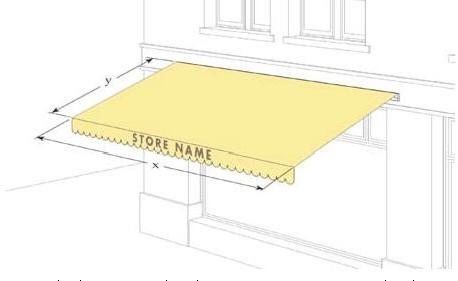
Figure 2
(4) Backlit Translucent Panels. Backlit translucent panels and spandrels, with or without text or graphics, are measured as the area of the height and width of any internally illuminated translucent panel, including the side panels if the structure or spandrel is greater than six inches in width.
(5) Multi-Face Signs. Multi-face signs, as shown in Figure 3, are measured as follows:
(A) Two-Face Signs. If the interior angle between the two sign faces is 45 degrees or less, the sign area is of one sign face only. If the angle between the two sign faces is greater than 45 degrees, the sign area is the sum of the areas of the two sign faces;
(B) Three- or Four-Face Signs. The sign area is 50 percent of the sum of the areas of all sign faces; and
(C) Spherical, free-form, sculptural or other nonplanar sign area is measured as 50 percent of the sum of the areas using only the four vertical sides of the smallest four-sided polyhedron that will encompass the sign structure. Signs with greater than four polyhedron faces are prohibited.
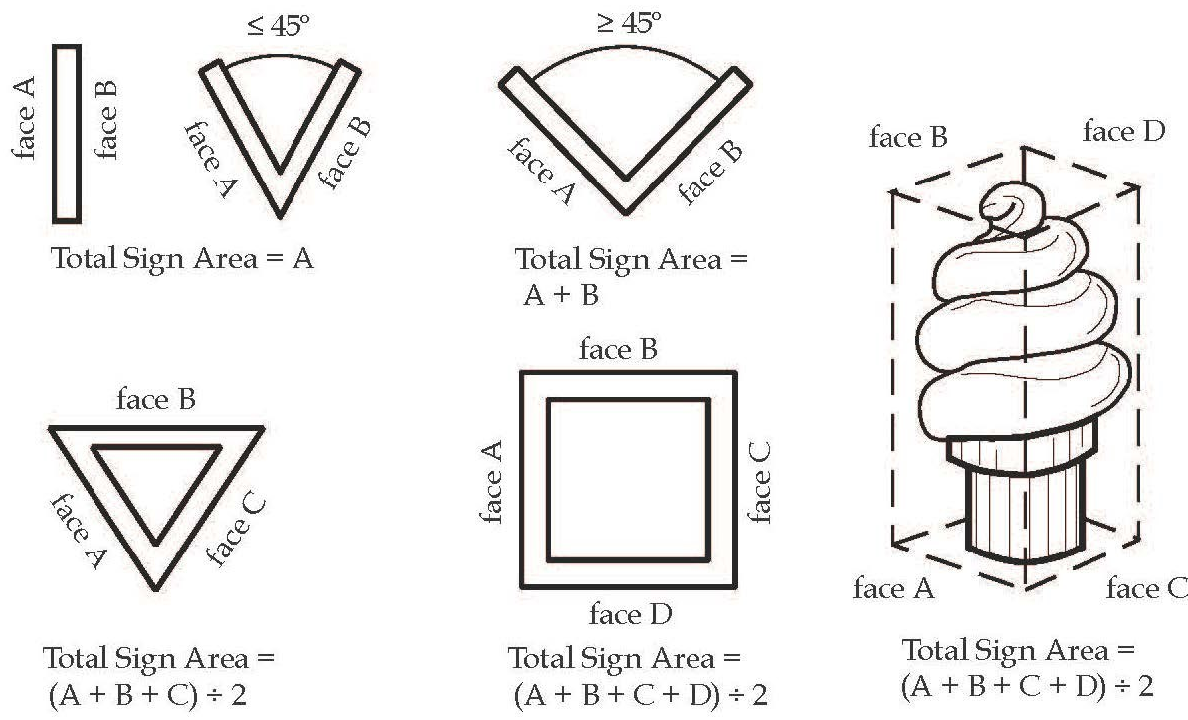
Figure 3
(b) Sign Height Measurement for Freestanding Signs. Sign height is measured as the vertical distance from natural grade at the base of a sign to the top of the sign, including the sign support structure; except that signs within 15 feet of an adjacent road may be measured as follows:
(1) If natural grade at the base of a sign is higher than the grade of the adjacent road, sign height shall be measured from the base of the sign as shown in Figure 4.

Figure 4
(2) If natural grade at the base of the sign is lower than the grade of an adjacent road, the height of the sign shall be measured from the top of curb or road-grade elevation; provided, that fill is placed between the curb and the sign and extends at least five feet beyond the base of the sign in all directions, as shown in Figure 5.

Figure 5
(c) Sign Structure and Installation.
(1) Support Elements. Any angle iron, bracing, guy wires or similar features used to support a sign shall not be visible.
(2) Electrical Service. When electrical service is provided to freestanding signs or landscape wall signs, all such electrical service is required to be underground and concealed. Electrical service to building-mounted wall signs, including conduit, housings and wire, shall be concealed or, when necessary, painted to match the surface of the structure upon which they are mounted. A building permit (electrical) must be issued prior to the installation of any new signs requiring electrical service.
(3) Raceway Cabinets. Raceway cabinets, where used as an element of building-mounted wall signs, shall match the building color at the location of the building where the sign is located. Where a raceway cabinet provides a contrast background to sign copy, the colored area is considered part of the sign face and is counted in the aggregate sign area permitted for the site or business. Examples of raceway cabinets are shown in Figure 6.

Figure 6
(4) Limitation on Attachments and Secondary Uses. All permitted sign structures and their associated landscape areas shall be kept free of supplemental attachments or secondary uses including, but not limited to, supplemental signs not part of a permitted sign, light fixture, newspaper distribution racks or trash container. The use of sign structures and associated landscape areas as bicycle racks or support structures for outdoor signs is prohibited.
(d) Sign Placement.
(1) Signs shall not be placed or erected on or over any public street, public alley, or any other public property including rights-of-way or utility easements within the corporate limits of the city, except as expressly provided for in this chapter. Any sign placed upon private property shall require the permission of the property owner.
(2) No sign shall be erected or placed in a manner that will block or impair or impede pedestrian or vehicular traffic on streets, alleys, driveways, or points of ingress-egress, or conflict with the clear vision triangle standards in FMC 22.58.005.
(3) No sign may be mounted, attached or painted on a trailer, boat or motor vehicle that is parked, stored or displayed conspicuously on private premises in a manner intended to attract the attention of the public. This excludes signs that are permanently painted or wrapped on the surface of the vehicle, or adhesive vinyl film affixed to the interior or exterior surface of a vehicle window, or signs magnetically attached to motor vehicles or rolling stock that are actively used in the daily conduct of business. However, such vehicles shall be operable and parked in a lawful or authorized manner. (Ord. 1598 § 11, 2017; Ord. 1533 § 1, 2013; Ord. 1322 § 1, 2003).
22.26.012 Illumination standards.
(a) General. No temporary sign may be illuminated. No sign located in Group 2 (residential) may be illuminated. Permanent signs allowed by this chapter may be nonilluminated, or illuminated by internal light fixtures, halo illuminated, or have external indirect illumination, unless otherwise specified. All illuminated signs shall comply with the time limitations of subsection (d) of this section.
(b) Externally Illuminated Signs.
(1) Except as provided in this subsection, externally illuminated signs shall be illuminated only with steady, stationary, fully shielded light sources directed solely onto the sign without causing glare. Light shielding shall ensure that the lamp or light source is not visible beyond the premises and shall further ensure that the light is contained within the sign face.
(2) A light fixture mounted above the sign face may be installed with its bottom opening tilted toward the sign face, provided:
(A) The bottom opening of the light fixture is flat (i.e., it could be covered by a flat board allowing no light to escape); and
(B) The uppermost portion of the fixture’s opening is located no higher than the top of the sign face, as shown in Figure 7 below. Light fixtures aimed and installed in this fashion shall be considered fully shielded.
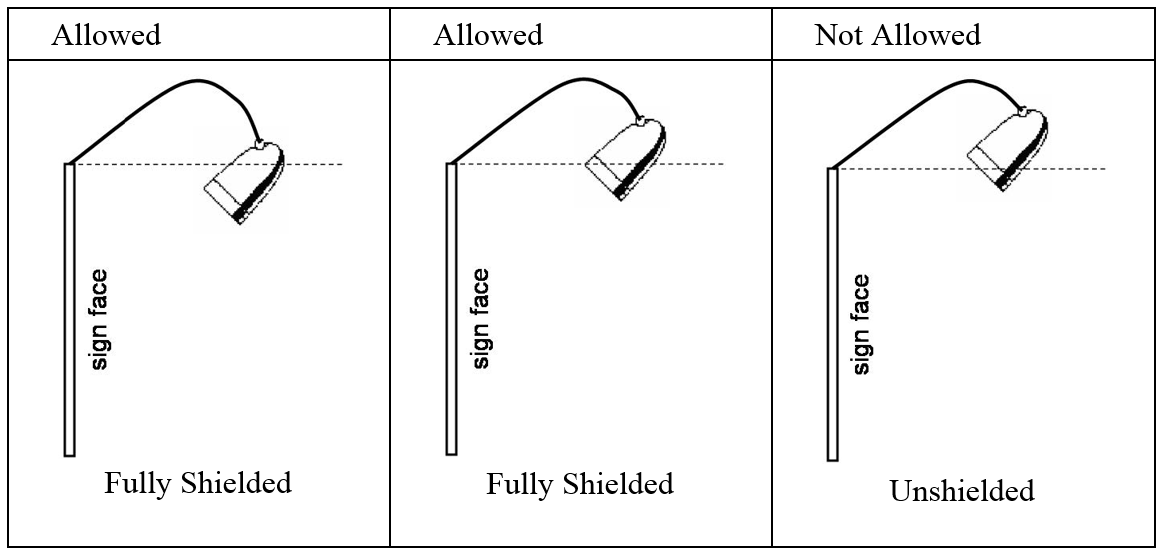
Figure 7
(c) Internally Illuminated Signs.
(1) This chapter provides incentives to encourage internally illuminated signs to be constructed with an opaque background and translucent text and symbols (see FMC 22.26.017(f) and 22.26.023(a)).
(2) In no case may an internally illuminated sign or a digital sign exceed a light output of 100 nits in Group 1 (nonresidential/noncommercial) or Group 3 (nonresidential) during nighttime hours.
(3) Neon sign lighting is allowed in Group 3 (nonresidential) only and shall not exceed 100 nits per sign face. Neon signs with solid backgrounds are not allowed in windows in order to ensure maximum light and visibility through windows.
(d) Time Limitations. All illuminated signs over three square feet in area shall be turned off by 11:00 p.m., or when the business closes, whichever is later. Signs subject to time limitations are required to have functioning and properly adjusted automatic shut-off timers. (Ord. 1598 § 12, 2017; Ord. 1322 § 1, 2003).
22.26.013 Accessory signs.
(a) Accessory Signs.
(1) Number. A maximum of one sign at each vehicle point of entry or egress, not to exceed four accessory signs per site.
(2) Design. Nonilluminated or internal illumination only. Any accessory sign with electronic display must conform to all digital sign standards in FMC 22.26.016.
(3) Sign Area. Maximum area three square feet per sign.
(4) Wall Sign Height and Mounting. Maximum height eight feet above grade; must be mounted flat against building wall.
(5) Freestanding Sign Height. Maximum height three feet above grade (see Figure 8).
(6) Location. Accessory signs may be permitted in Group 1 (nonresidential/noncommercial) and in Group 3 (commercial).
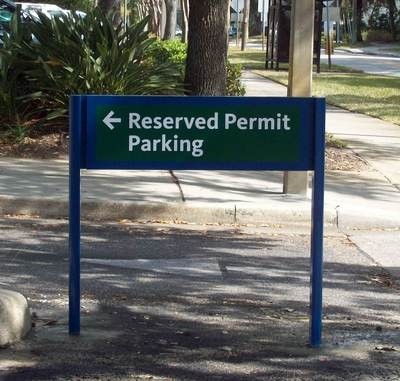
Figure 8
(b) Drive-Through Large Accessory Signs. In addition to the accessory signs allowed for vehicle points of entry and in addition to freestanding signs otherwise allowed under FMC 22.26.017, large accessory signs are allowed for each point of entry to a drive-up window, subject to the following standards:
(1) Sign Area per Drive-Up Point of Entry. Maximum 48 square feet;
(2) Sign Height. Maximum six feet, including the associated sign structure;
(3) Orientation. Must be oriented so the sign face is not visible from the street or public-right-of way;
(4) Screening. All sides of sign must be screened from view from the street or public right-of-way with landscaping or walls of brick, stone or siding materials that match the principal walls of the building to which the sign applies. If landscaping is used for screening, it must provide full screening at maturity and must be large enough at planting to provide at least 75 percent screening of the sign;
(5) Audio. No sound or amplification may be emitted that is audible beyond the site; and
(6) Location. Drive-through large accessory signs may be permitted only in Group 3 (commercial).
(c) Accessory Structure Signs. A freestanding structure housing an activity that is accessory to the principal tenant of a site in Group 3, such as an ATM kiosk, shall be permitted wall signage; provided, that the total wall sign area does not exceed the maximum allowed in FMC 22.26.023, Table 3.
(d) Internal Signs.
(1) Placement. Signs may be located on internal walkways or landscape islands, provided they do not inhibit pedestrian movement along a pathway.
(2) Sign Area. Maximum 15 square feet.
(3) Sign Height. Maximum five feet.
(4) Design. Signs shall be designed in a uniform manner (within an individual center or complex) using consistent background color and typeface colors. Dark background colors with light colored text are required. See Figure 9 for examples.
(5) Location. Internal signs may be permitted in Group 1 (nonresidential/noncommercial) and Group 3 (commercial).
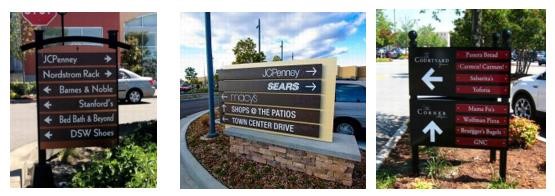
Figure 9
(Ord. 1598 § 13, 2017; Ord. 1322 § 1, 2003).
22.26.014 Awning, canopy and marquee signs.
(a) Awning, canopy and marquee signs may be used in place of permitted wall signs (except where otherwise specified herein), provided they comply with the following standards:
(1) Number. One awning, canopy or marquee sign is allowed for each primary entrance to a building or tenant space. In addition, one awning, canopy or marquee sign may be allowed on a secondary entrance that faces a public street or on-site parking area. (As used in this subsection, “street” excludes alleys and service ways.) The awning, canopy or marquee sign may only be placed on the ground floor level facade of the building;
(2) Sign Area. See Table 3 in FMC 22.26.023 for maximum sign area for all awning, canopy, marquee and wall signs combined;
(3) Sign Width. The awning, canopy, or marquee sign shall not extend horizontally a distance greater than 60 percent of the width of the awning, canopy or valance on which it is displayed;
(4) Letter Height. The lettering height shall be proportional to the architectural features of the building and not exceed eight inches in height. For example, it shall not be so large that it blocks windows or other significant architectural features of the building;
(5) Placement.
(A) An awning or canopy sign may not be mounted higher than a maximum of 25 feet above the floor level of the ground floor (see Figure 10);
(B) An awning or canopy sign shall not project above, below or beyond the edges of the face of the building wall or architectural element on which it is located;
(C) No part of the sign, as a part of or displayed on the vertical surface of an awning or canopy, shall project beyond the edges of the awning or canopy surface on which it is displayed. If an awning or canopy is placed on multiple tenant spaces, each tenant space is permitted signage no greater than 60 percent of the width of the tenant space;
(D) Signs shall be placed on the front flap only rather than on the top-sloped awning area; and
(E) Signs shall be placed a minimum of eight feet above the sidewalk or walkway;
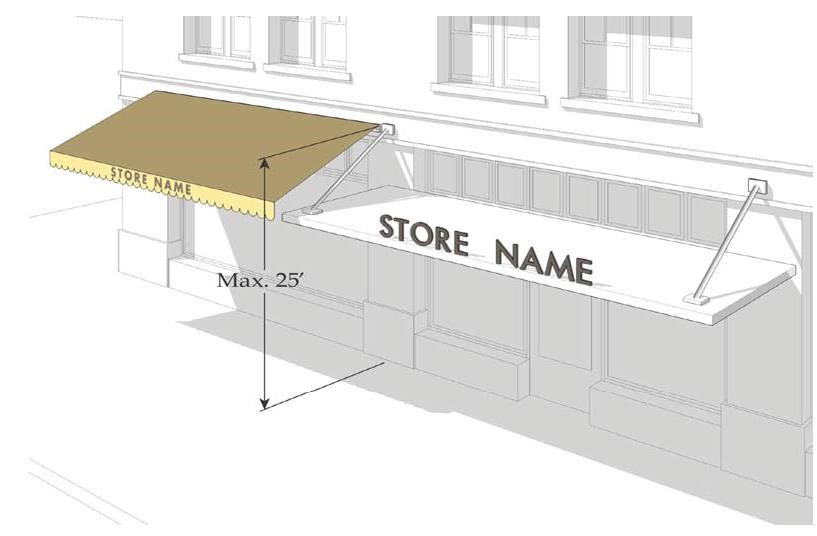
Figure 10
(6) Illumination. If sign letters or logos are placed on an awning, canopy or marquee, only the face area containing the letters or logos may be illuminated. All illumination must be internal behind the surface of the awning, canopy or marquee. The sign may also be nonilluminated; and
(7) Location. Awning, canopy and marquee signs may be permitted in Group 1 (nonresidential/noncommercial) and Group 3 (commercial). (Ord. 1598 § 14, 2017; Ord. 1322 § 1, 2003).
22.26.015 Changeable copy sign.
Changeable copy signs (see Figure 11) may be used in place of permitted freestanding signs and wall signs (except where otherwise specified herein), provided they comply with the following standards:
(a) Number. A maximum of one changeable copy sign per parcel or group of parcels that form a center or complex, or other site or facility, except that additional changeable copy signs are permitted as follows:
(1) The additional changeable copy sign(s) must be placed at least 100 feet from abutting streets or rights-of-way; and
(2) The additional changeable copy sign(s) must not exceed the maximum area, height, and quantity standards otherwise applicable to any freestanding or building-mounted wall signs on the parcel.
(b) Sign Area. A maximum 20 percent of the allowed wall sign area or 50 percent of a freestanding sign face may be changeable copy (this does not apply to signs required by law). Wall-mounted changeable copy signs placed at least 100 feet from abutting streets may be a maximum of 50 percent of permitted wall sign area.
(c) Sign Height above Grade. Limited to the maximum height allowed for freestanding signs and 15 feet maximum for wall signs.
(d) Placement/Location. Allowed only as an integral part of a wall sign or a freestanding sign.
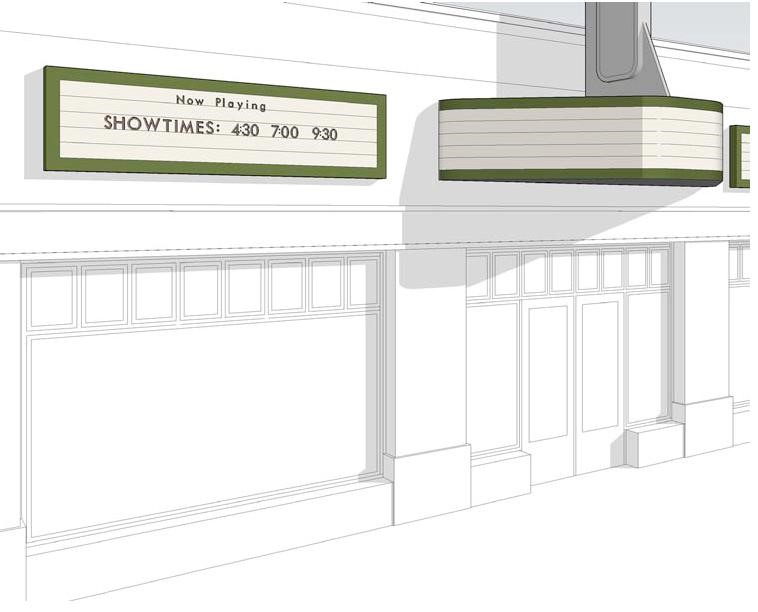
Figure 11
(e) Illumination. Internally or indirectly illuminated, subject to the illumination standards in FMC 22.26.012.
(f) Location. Changeable copy signs may be permitted in Group 1 (nonresidential/noncommercial) and in Group 3 (commercial). (Ord. 1598 § 15, 2017; Ord. 1322 § 1, 2003).
22.26.016 Digital signs.
(a) Sign Area. Maximum 16 square feet.
(b) Density. One digital sign per parcel or group of parcels that form a center or complex, or other site or facility, with street frontage of at least 150 feet.
(c) Luminance. Maximum 50 nits during nighttime hours.
(d) Motion Limits. No motion except for instantaneous change of message.
(e) Hold between Messages. Minimum eight seconds.
(f) Programming. To ensure that digital signs are programmed and continue to operate according to local standards, digital signs shall be designed for local on-site control and programming.
(g) Digital Signage Integration. Digital signage elements may be integrated into any freestanding sign or wall sign permitted in this section, provided no more than 50 percent of allowed sign copy area, not to exceed 16 square feet, may be used for digital purposes.
(h) Location. Digital signs may be permitted in Group 1 (nonresidential/noncommercial) and in Group 3 (commercial). (Ord. 1598 § 16, 2017; Ord. 1322 § 1, 2003).
22.26.017 Freestanding signs.
(a) Number. The number of freestanding signs for single- and multiple-tenant uses is derived from the location and length of development site frontage as described below:
(1) One freestanding sign for each 150 feet of site frontage up to a maximum of three freestanding signs per frontage. Flag lot sites with frontage on a public street are permitted one sign only on the frontage providing primary access to the site.
(2) For properties with more than 300 feet of frontage and two or more freestanding signs, such signs shall be separated by at least 150 feet.
(3) Where more than one freestanding sign is proposed on a site with multiple frontages, a minimum of 60 linear feet shall separate a sign on one frontage from a sign on another frontage.
(b) Sign Form. Signs shall be designed so they appear firmly anchored to the ground. Examples include monument signs and other signs where the sign base has a minimum aggregate width of 40 percent of the sign cabinet or face, as shown in Figure 12.

Figure 12
(c) Placement.
(1) A minimum of five feet from the property line abutting a street, a minimum of 10 feet from any interior side lot line, or a minimum of 25 feet from any Group 1 (nonresidential or noncommercial) or Group 2 (residential) properties.
(2) No freestanding sign shall be located in a manner that will block or impair or impede pedestrian or vehicular traffic on streets, alleys, driveways, or points of ingress-egress, or conflict with the clear vision triangle standards in FMC 22.58.005.
(d) Materials and Design. Signs shall be designed as an integrated architectural feature of the site as described and illustrated in Figures 13 and 14 below:
(1) Framing. Signs must include design elements that effectively frame the sign on both sides. Alternatively, signs that have a substantial framing element on one side will meet this provision;
(2) Materials and Design. Signs shall include durable high quality materials and a design that relates to and/or complements the design of on-site buildings and/or is coordinated with other site design elements (such as distinctive lighting, monuments, internal signs); and
(3) Top/Middle/Bottom. Signs shall integrate a top, middle, and bottom element. The top should include a distinctive sign cap. The middle should include a consistent framing technique for an individual sign or multiple signs in a multi-tenant center. The bottom should include a distinctive base design with special materials and/or design. These elements are less critical for signs less than six feet tall, which are exempt from this provision.
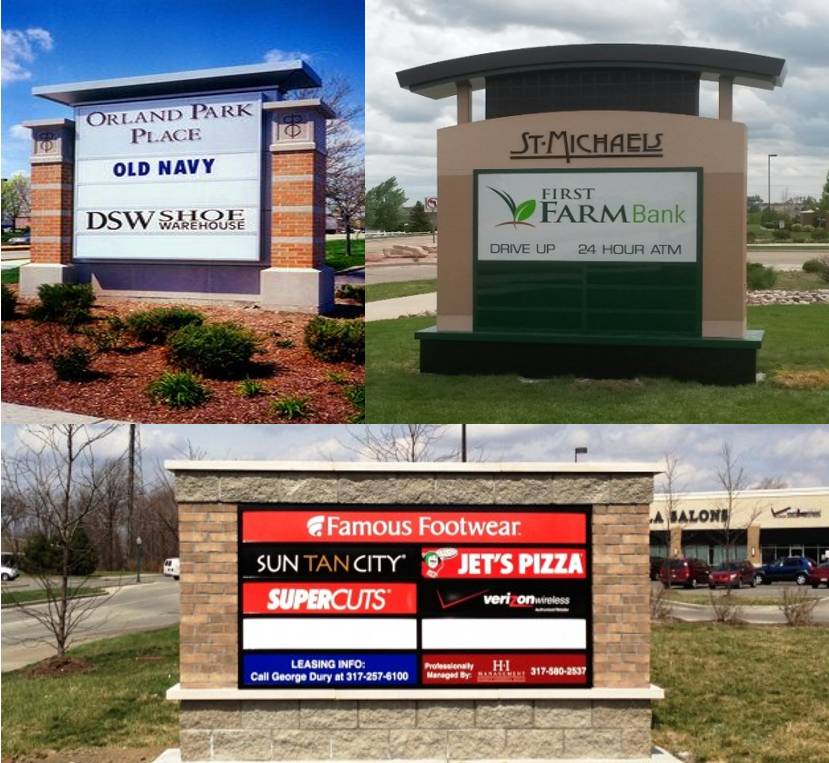
Figure 13
Signs including a frame and top/middle/bottom elements
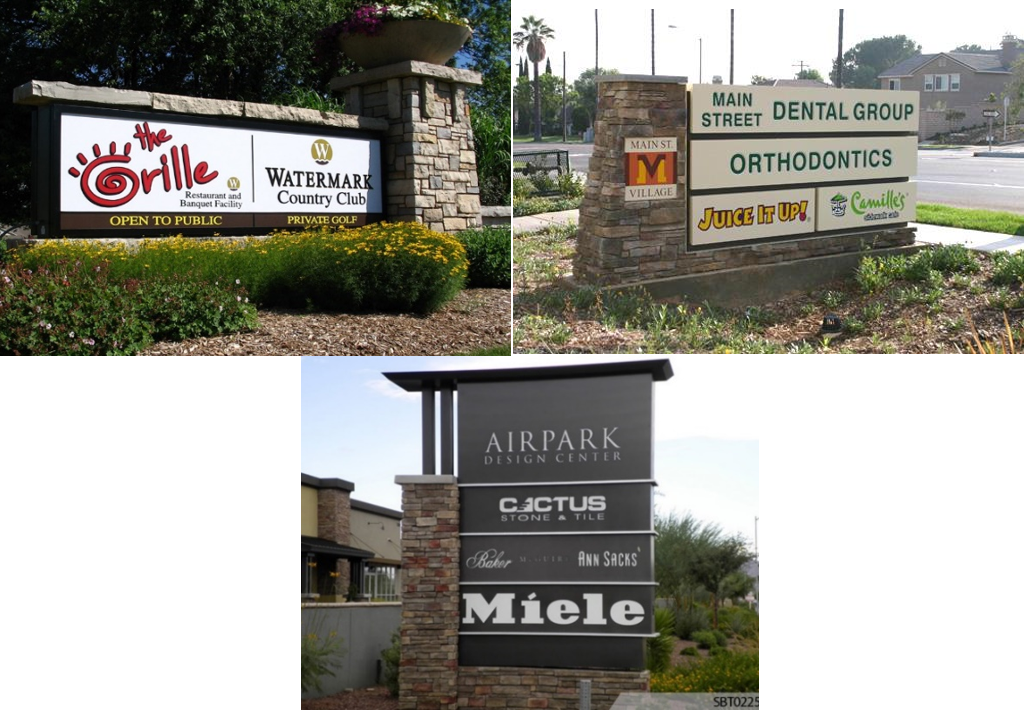
Figure 14
Signs featuring substantial framing elements on one side
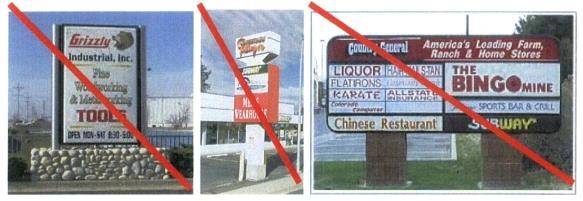
Figure 15
Unacceptable signs
The sign on the left includes a base and a frame, but no identifiable top.
The middle sign and sign on the right fail to meet any of the design provisions above.
(e) Landscaping.
(1) Landscaping is required around the base of freestanding signs to enhance the character of street frontages. At least one square foot of landscaped area shall be provided per one square foot of sign area. Utilize plants and a maintenance program to minimize conflicts with the sign.
(2) Base Height Provision. The copy of all signage shall be at least one foot above grade to allow vertical space for the required landscape elements and enhance the visibility of sign copy. See Figure 16.
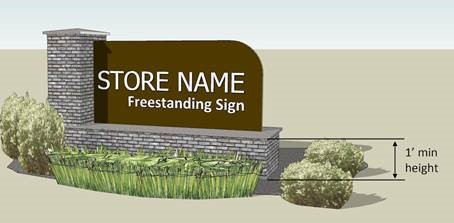
Figure 16
(f) Area and Height.
(1) Table 2 illustrates the maximum allowable sign area and height for all freestanding signs.
|
Total ROW Frontage of Parcel |
Allowable Sign Area |
Allowable Sign Area |
Maximum Height |
Maximum Height |
|---|---|---|---|---|
|
<100 feet |
24 sq. ft. |
40 sq. ft. |
4 feet |
6 feet |
|
100 – 275 feet |
32 sq. ft. |
50 sq. ft. |
5 feet |
7 feet |
|
>275 feet |
40 sq. ft. |
60 sq. ft. |
6 feet |
8 feet |
(2) Signs that employ shaded, opaque or dark background and light colored lettering for at least 50 percent of the sign copy are allowed larger sign areas, as they are found to be less visually intrusive than signs incorporating white or very light-colored background. Using a CMYK color chart, signs that employ color numbers that add up to at least 20 (collectively) shall be considered as “shaded.” For example:
|
C=0, |
M=0, |
Y=0, |
K=20 |
= |
Shaded |
|
C=10, |
M=0, |
Y=0, |
K=10 |
= |
Shaded |
|
C=10, |
M=0, |
Y=0, |
K=0 |
= |
Not considered to be shaded |
See Figure 17 below for examples. The black, dark, and shaded signs qualify for the extra sign area and height specified in the shaded columns of Table 2. The sign on the right with the white background is allowed but does not qualify for the “bonus” sign area and height and is subject to the sign area/height limits in the unshaded columns in Table 2.

Figure 17
(3) For those properties where more than one freestanding sign is allowed on a particular frontage per subsection (a) of this section, one sign may be installed per standards specified per the total ROW frontage of the parcel. The size and height of additional signs are based on the separation from the larger primary sign or other supplemental sign. For example, if a second sign is 250 feet from the larger primary sign, then it shall meet the standards for a sign that includes 100 through 299 feet of total ROW frontage of parcel as set forth in Table 2.
(g) Address Numbers. Legible address numbers are required on all freestanding signs. Such address numbers are exempt from sign area standards.
(h) Location. Freestanding signs may be permitted in Group 1 (nonresidential/noncommercial) and Group 3 (commercial). (Ord. 1598 § 17, 2017; Ord. 1322 § 1, 2003).
22.26.018 Portable signs.
(a) No Permit Required. No sign permit is required for portable signs.
(b) Design and Materials. Portable signs must be designed with durable materials; otherwise they will be regulated as temporary signs under FMC 22.26.021. Portable signs must be designed to withstand wind and include a heavy weighted base for pole-mounted signs, and a heavy weight suspended between the opposing faces of a sandwich board sign.
(c) Size and Height (See Figure 18).
(1) Sandwich Board Signs. Maximum four feet in height and three feet in width. (Note: sandwich board sign height is measured in the flat standing position, rather than in open standing position.)
(2) Pole-Mounted Signs. Maximum four feet in height and three feet in width.
(3) Feather Signs. Maximum 13 feet in height.
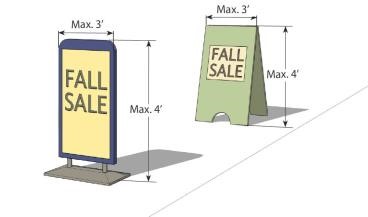
Figure 18
(d) Number, Location and Spacing.
(1) Sandwich Board or Pole-Mounted Sign. One sandwich board or pole-mounted sign may be displayed per tenant space. Signs shall be located within 12 feet of the primary building entrance.
(2) Feather Sign. A feather sign may be displayed in lieu of a portable sandwich board or pole-mounted sign. Spacing of feather signs shall be no closer than 100 feet apart on a property frontage as shown in Figure 19. Each property may qualify for one feather sign regardless of frontage length.

Figure 19
Feather signs shall be placed at intervals of no more than one sign per 100 lineal feet of frontage and located behind the sidewalk outside the public ROW.
(e) Placement. No portable sign may be located on city right-of-way, including sidewalk, without city approval. Such signs shall not be placed within a clear vision triangle (see FMC 22.58.005) or any location that will impede vehicular traffic. Further, such signs shall not be placed in a manner that will block or otherwise obstruct the safe use of sidewalks, building entrances or stairs by pedestrians, including pedestrians who are visually impaired or otherwise handicapped.
(f) Display Hours. During business or operating hours only.
(g) Location. Portable signs (durable and temporary) may be permitted in Group 1 (nonresidential/noncommercial) and Group 3 (commercial), and temporary portable signs may be permitted in Group 2 (residential). Temporary portable signs are subject to the provisions of FMC 22.26.021. Feather signs are permitted only in the MUN and MUU zones.
(h) Visually Obscured Building Signage. In order to provide increased visibility for businesses and other tenants located in buildings that are visually obscured from public street frontage by an intervening building, sandwich or pole-mounted signs may be placed along the arterial street frontage in lieu of these signs being placed within 12 feet of the primary entrance to the rear building or business, subject to the following limitations:
(1) The property is located within an MUU, MUN, or NC zone.
(2) Signs shall be placed on private property subject to the property owner’s permission.
(3) The number of signs shall be limited to one per tenant.
(4) Spacing shall be no closer than 40 feet apart to minimize their visual impact. (Ord. 1667 § 5, 2020; Ord. 1598 § 18, 2017).
22.26.019 Projecting signs.
(a) Projecting signs may be used in lieu of or in addition to wall, awning, canopy or marquee signs provided they comply with the following standards:
(1) Number.
(A) Projecting Signs. One projecting sign may be allowed per tenant space or building frontage that is visible from a street or customer parking lot.
(B) Projecting Banner Signs. Multiple banner signs may be integrated on building if aligned with facade articulation elements (such as vertical columns or piers). See Figure 20 for examples.
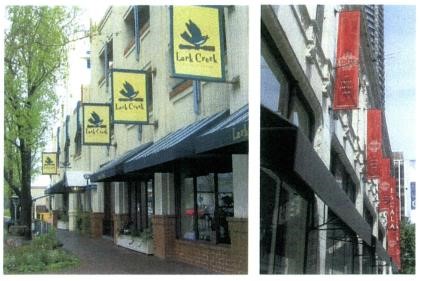
Figure 20
(2) Area. Maximum eight square feet.
(3) Orientation. Projecting signs may be either vertically or horizontally oriented. Projecting banner signs must be vertically oriented.
(4) Projection. See Figure 21.
(A) Horizontally oriented signs shall not project more than eight feet;
(B) Vertically oriented signs shall not project more than 42 inches for single-story buildings or more than five feet for multi-story buildings;
(C) Signs may project over a sidewalk into a public right-of-way subject to city approval but shall not extend over a parking area or travel lane.
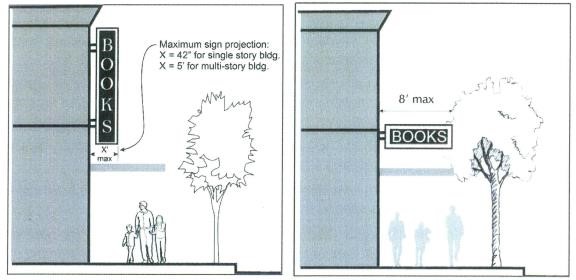
Figure 21
Standards for vertically (left) and horizontally oriented (right) projecting signs.
(5) Height.
(A) Horizontally oriented signs shall not exceed three feet.
(B) Vertically oriented signs shall not extend above the building parapet, soffit, the eave line or the roof of the building. See Figure 22 for unacceptable examples where signs project over the roofline and there is an excessive number of projecting signs resulting in unwanted clutter.
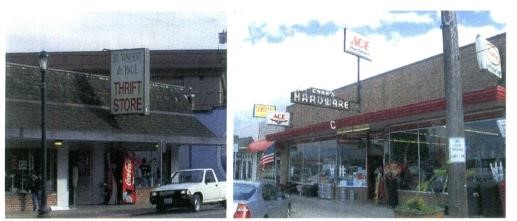
Figure 22
(6) Vertical Clearance. Signs shall be placed a minimum of eight feet above the sidewalk, walkway or driveway that is directly below the sign, or within three feet of the sign. See Figure 23.
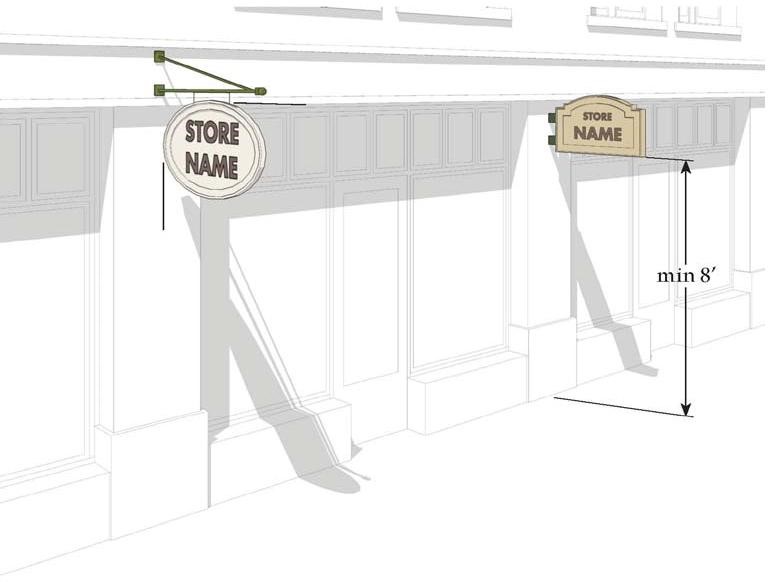
Figure 23
(7) Placement.
(A) Projecting signs shall not be located directly in front of windows or in conflict with other signs or architectural features of the building.
(B) No projecting sign shall be located within 25 feet of another projecting sign on the same site or on the same building. Projecting banner signs may be spaced closer than 25 feet when they are aligned with facade articulation elements (such as vertical columns or piers).
(8) Mounting.
(A) Signs shall be mounted perpendicular to the building wall to which they are affixed.
(B) Signs shall be supported by or suspended from solid rods or otherwise tethered or reinforced to avoid movement in wind.
(9) Location. Projecting signs and projecting banner signs may be permitted only in Group 3 (commercial). (Ord. 1598 § 19, 2017).
22.26.020 Service island signs.
(a) Number and Size.
(1) Island Canopies. One sign on the canopy fascia per street frontage, not to exceed 20 percent of the area of canopy fascia to which the sign is mounted. See Figure 24.
(2) Spandrel Signs and Island Spanner Signs. Spandrel signs shall not exceed 20 percent of the spandrel area, and both spandrel signs and island spanner signs attached to canopy support columns shall be deducted from allowable wall signage on the associated principal building on the site.
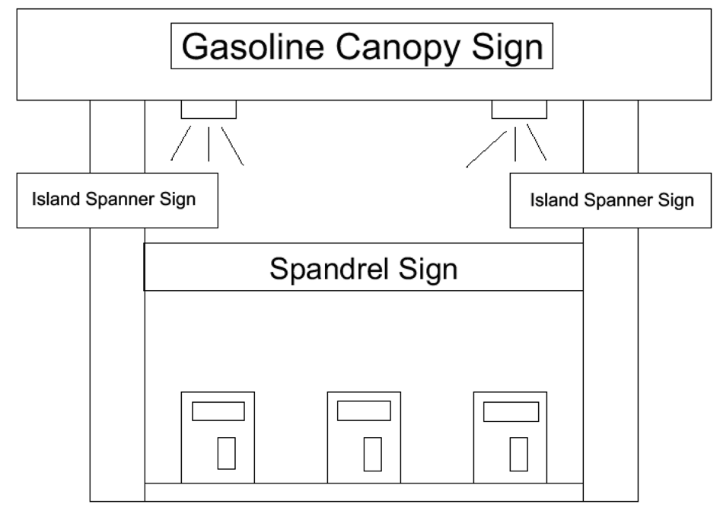
Figure 24
(b) Design. Spandrel signs may be internally illuminated, subject to the illumination standards of FMC 22.26.012. Island spanner signs attached to canopy support columns shall not be illuminated.
(c) Location. Service island signs may be permitted only in Group 3 (commercial). (Ord. 1598 § 20, 2017).
22.26.021 Temporary signs.
(a) No Permit Required. No sign permit is required for temporary signs.
(b) Removal. Temporary signs shall be removed if the sign is in need of repair, is worn, dilapidated or creates a public nuisance. Signs installed for periods exceeding 180 days shall be modified to meet the applicable standards for permanent (nontemporary) signs or be removed.
(c) Materials. Temporary signs must be made of nondurable materials including, but not limited to, paper, corrugated board, flexible, bendable or foldable plastics, foam core board, vinyl canvas or vinyl mesh products of less than 20-ounce fabric, vinyl canvas and vinyl mesh products without polymeric plasticizers, and signs painted or drawn with water soluble paints or chalks. Signs made of any other materials shall be considered permanent and are subject to the permanent sign regulations of this chapter.
(d) Location.
(1) City Property (Excluding City Right-of-Way). Temporary signs on city-owned property excluding city right-of-way are allowed only in conjunction with an approved special event permit.
(2) City Right-of-Way Outside of the Roadway. Temporary signs on city right-of-way placed outside of the roadway must comply with the following requirements:
(A) Placement. Allowed only between the property line and the back of the nearest curb, or where no curb exists, between the property line and the nearest edge of the pavement. Signs may not be placed on traffic islands, or on sidewalks, driveways or other paved areas designed for pedestrian or vehicular use, or as conditioned in a right-of-way use permit.
(B) Approval of Abutting Owner. Approval of the abutting owner is required.
(C) Type. Signs on stakes that can be manually pushed or hammered into the ground are allowed. All other signs are prohibited, unless specifically allowed by a right-of-way use permit.
(D) Area and Height. Maximum four square feet in area and three feet in height.
(E) Dilapidated or Nuisance Signs. Any temporary sign in the right-of-way that is dilapidated or a nuisance shall be removed by the person responsible for placement of the sign.
(F) Other Signs. The city may allow other signs in city right-of-way with a right-of-way use permit.
(3) Residential. Temporary signs may be placed in Group 2 (residential) in accordance with the requirements of this section and the following:
(A) Window Signs. Maximum one temporary window sign per residential unit, not to exceed four square feet in area.
(B) Freestanding Signs (Includes Pole-Mounted, Stake-Mounted and Portable Signs). Maximum six square feet in area and four feet in height. Spacing shall be no closer than 100 feet apart on a property frontage.
(C) Surface-Mounted Signs. Maximum one surface-mounted sign, not to exceed two square feet in area. Must be flatly affixed to walls below the fascia or parapet line, or flatly affixed to on-site fences either facing or abutting the street, or facing inward to the subject site. Signs shall not be attached or tethered to other site improvements.
(4) Nonresidential. Temporary signs may be placed in Group 1 (nonresidential/noncommercial) and Group 3 (commercial) in accordance with the requirements of this section and the following:
(A) Window Signs. Maximum four square feet or 10 percent of the area of the window in which they are placed, whichever is greater.
(B) Freestanding Signs (Including Pole-Mounted, Stake-Mounted and Portable Signs). Maximum eight square feet in area and four feet in height. Spacing shall be no closer than 100 feet apart on a property frontage.
(C) Surface-Mounted Signs. Maximum 32 square feet in area. Must be flatly affixed to walls below the fascia or parapet line, or flatly affixed to on-site fences either facing or abutting the street, or facing inward to the subject site. Signs shall not be attached or tethered to other site improvements. (Ord. 1598 § 21, 2017).
22.26.022 Under-canopy signs.
Under-canopy signs are placed under awnings, marquees or canopies and placed perpendicular to the storefronts and thus oriented to pedestrians on the sidewalk or an internal walkway. Under-canopy signs may be used in lieu of or in addition to wall, awning, canopy or marquee signs provided they comply with the following standards:
(a) Number. One for each entrance.
(b) Width. Limited by the projection of the canopy. There shall be a one-foot minimum distance between the sign and the outer edge of the marquee, awning, or canopy and between the sign and the building facade.
(c) Height. Maximum two feet in height.
(d) Vertical Clearance. Minimum of eight feet above the sidewalk or walkway. See Figure 25.
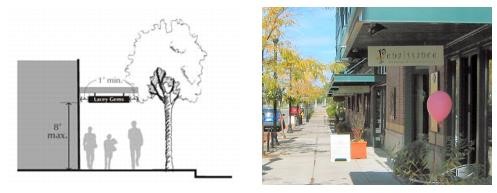
Figure 25
(e) Location. Under-canopy signs may be permitted only in Group 3 (commercial). (Ord. 1598 § 22, 2017).
22.26.023 Wall signs.
(a) Area.
(1) Groups 1 and 3. Maximum area of wall, awning, canopy, or marquee signage on each building elevation is provided in Table 3 below.
(2) Group 2. Maximum two square feet.
|
Table 3 |
|
|---|---|
|
Maximum sign surface area (White, very light or unshaded background) |
Maximum sign surface area (Black, dark or shaded background) |
|
1.5 sf of sign area per linear foot of storefront, tenant space, or building wall, not to exceed 75 sf |
2.0 sf of sign area per linear foot of storefront, tenant space, or building wall, not to exceed 100 sf |
(b) Placement and Design.
(1) Wall signs shall be proportional and shaped to the architectural features of the buildings. Signage shall not exceed 60 percent of the width of the wall plane upon which the sign is placed or the width of the tenant space, per Figure 26. Signage shall not exceed 70 percent of the height of the blank wall space or fascia on which the sign is located. These standards also apply to upper level tenant space.
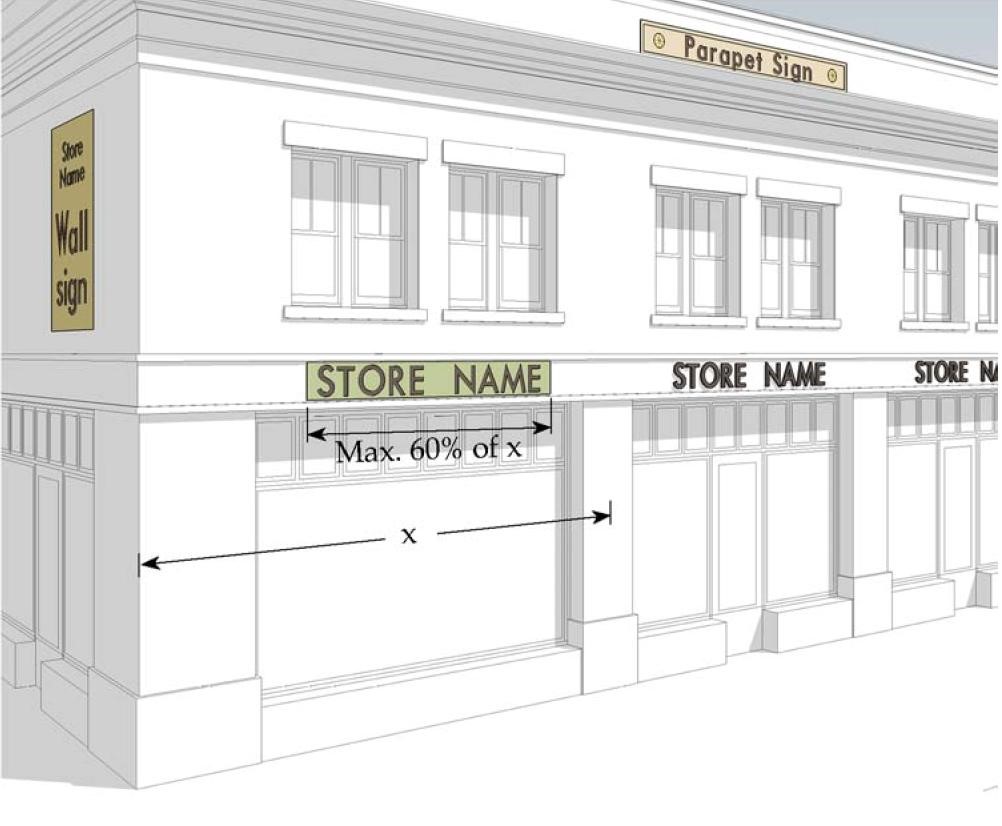
Figure 26
(2) Wall signs shall not cover important architectural details of a building such as stair railings, windows, doors, building trim, or special ornamentation features. Preferred areas for installation of wall signs include blank areas above canopies, areas between vertical piers or columns, blank areas under a gabled roof, or upper reaches of a false fronted building.
(3) Tenants on upper levels may include wall signs placed on the facade above the ground floor tenant, provided the permitted sign area shall be shared with tenant below and the location/design meets the applicable standards in this subsection.
(4) Wall signs may not extend above the building parapet, soffit, the eave line or the roof of the building.
(c) Mounting.
(1) Building signs should be mounted plumb with the building, with a maximum protrusion of one foot unless the sign incorporates sculptural elements or architectural devices.
(2) All individual letter signs shall be installed to appear flush-mounted unless a pin-mounted design is used to accommodate backlit lighting. If the letters are illuminated and require a raceway, the letters shall be installed tight against the raceway, which shall be painted to match the color of the surface to which the raceway is mounted. Where possible, especially on new construction, the raceway should be recessed to allow letters to be flush with the wall surface.
(3) The sign frame shall be concealed or integrated into the building’s architectural character in terms of form, color, and materials.
(d) Location. Wall signs may be permitted in Group 1 (nonresidential/noncommercial), Group 2 (residential), and in Group 3 (commercial). (Ord. 1673 § 2, 2021; Ord. 1598 § 23, 2017).
22.26.024 Window signs.
Window signs may be used in place of permitted wall signs (except where otherwise specified herein), provided they comply with the following standards:
(a) Number. One permanent window sign may be placed in a single window.
(b) Area. Maximum four square feet or 10 percent of the area of the window in which they are placed, whichever is greater (temporary and permanent window signs combined). These area limits apply to individual windows or to window units separated from another window or window unit by a pier, column, or other substantial architectural element. These limits do not apply to uses providing commercial services located within an MUN or MUU zone located at least 150 feet from a public or private street.
(c) Location. Permanent signs shall not be placed in windows above the second story level. For the requirements applicable to temporary window signs, see FMC 22.26.021.
(d) Design. Permanent signs are limited to individual painted or vinyl cut-out letters and graphics, or neon signs constructed without a solid or opaque background. Permanent signs with solid backgrounds or opaque backgrounds are not permitted in windows to ensure maximum light and visibility through windows. Temporary window signs are exempt from these design restrictions.
(e) Location. Window signs may be permitted in Group 1 (nonresidential/noncommercial) and in Group 3 (commercial). (Ord. 1667 § 6, 2020; Ord. 1598 § 24, 2017).
22.26.025 Exemptions.
The following are exempt from the permit requirements of this chapter:
(a) Painting, repainting, cleaning, repairing and other normal maintenance, unless structural or electrical changes are made;
(b) Temporary signs on private property or public property, meeting the requirements in FMC 22.26.021;
(c) Governmental Signs. Signs installed by the city, county, or a federal or state governmental agency for the protection of the public health, safety and general welfare, including, but not limited to, the following:
(1) Emergency and warning signs necessary for public safety or civil defense;
(2) Traffic and/or wayfinding signs erected and maintained by an authorized public agency;
(3) Signs required to be displayed by law;
(4) Signs showing the location of public facilities;
(5) Entrance signs, readerboard signs, or other community-oriented signs installed and maintained by the city; and
(6) Any sign, posting, notice, or similar sign placed by or required by a governmental agency in carrying out its responsibility to protect the public health, safety and general welfare;
(d) Temporary Signs in Windows. Any temporary sign taped or otherwise affixed to the inside of a window, in such a manner as to be easily removed; provided, that the total area of such sign in any one window does not exceed the square footage limitations in FMC 22.26.021 (Temporary signs) and 22.26.024 (Window signs);
(e) Interior Signs. Signs or displays located entirely inside of a building and located at least three feet away from transparent doors and windows;
(f) Vehicle Signs. Any sign on a vehicle, unless such vehicle is parked or stationed near an activity for the primary purpose of attracting public attention to such activity, unless such vehicle or mobile unit is regularly parked in any prominently visible location for the primary purpose of attracting public attention to the sign;
(g) Changes to the face or copy of changeable copy signs and digital signs, provided such changes do not change the material or appearance of the sign as originally permitted by the city;
(h) Sculptures, fountains, mosaics, and design features that do not incorporate advertising or identification;
(i) Any flags, provided that they conform to all provisions of this chapter for signs;
(j) Building identification numbers as required pursuant to Chapter 12.26 FMC or any other city or state regulation;
(k) Certain Historic and Architectural Features. Stone or cement plaques and cornerstones with engraved or cast text or symbols and permanently embedded in the building's foundation or masonry siding materials; provided, that none of these exceed four square feet in area;
(l) Signs not intended to be viewed by the public from the street right-of-way that are not visible from adjacent property. Examples include signs located within an enclosed or partially enclosed lobby or courtyard of any building or group of buildings that are designed and located to be viewed exclusively by patrons of such use or uses, and kiosks and other related informational signs that are placed along internal walkways that are designed specifically to be viewed by pedestrians and not intended to function as advertising to motorists on nearby public streets. (Ord. 1674 § 2, 2021; Ord. 1598 § 25, 2017).
22.26.026 Prohibited signs.
From and after the effective date of the ordinance codified in this chapter, it is unlawful for any person to maintain, erect or place within the city:
(a) Animated Signs. Rotating or revolving signs, or signs where all or a portion of the sign moves in some manner. This includes any sign animated by any means, including fixed aerial displays, balloons, pennants, spinners, propellers, whirling, or similar devices designed to flutter, rotate or display other movement under the influence of the wind, including flag canopies not otherwise allowed in FMC 22.26.014 (Awning, canopy and marquee signs), streamers, tubes, or other devices affected by the movement of air or other atmospheric or mechanical means. This does not include historic signs and historic replica signs where the applicant is able to prove, through documentation or other evidence, that the original historic sign produced the same motion/movement and is proposed in the same location;
(b) Nuisance Signs. Any signs that emit smoke, visible particles, odors and sound;
(c) Mobile Signs, Including Those Attached to or Placed upon a Vehicle or Trailer Parked on Private or Public Property. This provision is not to be construed as prohibiting the identification of a firm or its principal products on a vehicle operating during the normal course of business;
(d) Flashing Signs or Lights. A sign that contains an intermittent or flashing light source, or a sign that includes the illusion of intermittent or flashing light by means of animation, or an externally mounted intermittent light source. Flashing light sources are prohibited. Signs with an exposed light source, including clear light bulbs that do not flash on a theater marquee except for neon incorporated into the design of the sign, are also prohibited. Digital signs are allowed under the provisions of FMC 22.26.016;
(e) Any sign that constitutes a traffic hazard or detriment to traffic safety because of its size, location, movement, content, or method of illumination or that obstructs the vision of drivers or detracts from the visibility of any official traffic control device because it diverts or tends to divert the attention of drivers of moving vehicles away from traffic movement on streets, roads, intersections, or access facilities. No sign shall be erected so that it obstructs the vision of pedestrians, or which by its glare or by its method of illumination constitutes a hazard to traffic. No sign may use words, phrases, symbols or characters in such a manner as to interfere with, mislead, or confuse the steady and safe flow of traffic;
(f) Any sign or advertising structure or supporting structure that is torn, damaged, defaced or destroyed;
(g) Abandoned sign, including signs whose face has been removed or is broken and is not refaced within 180 days thereafter. Abandoned signs shall also include signs with rusted, faded, peeled, cracked or otherwise deteriorated materials or finishes that have not been repaired within 90 days after the city provides notice of the sign’s deteriorated condition in accordance with Chapter 22.95 FMC;
(h) Signs attached to utility poles, street lights, fire hydrants, trees, rocks or other natural features except those signs approved as part of a special event permit on city property or banner signs permitted by the city on street lights or utility poles;
(i) Bench signs greater than one square foot in area;
(j) Permanent signs on vacant lots, parcels or easements. No permanent sign shall be located on a vacant lot, parcel or easement. No permanent sign shall be located on a lot, parcel or easement as the principal use of that lot, parcel or easement. Signs may only be established as an accessory use to a principally permitted use;
(k) Roof signs, including signs painted directly on the roof surface; and
(l) Signs that may impede free ingress and egress from any door, window or exit way required by building and fire regulations. (Ord. 1598 § 26, 2017).
22.26.027 Liability.
This chapter shall not be construed to relieve from or lessen the responsibility of any person owning, building, altering, constructing, removing or moving any sign in the city. For damages to anyone injured or damaged either in person or in property by any defect therein, the city, or any agent thereof, shall not be held as assuming such liability by reason of permit or of inspection authorized herein or of certificate of inspection issued by the city or any of its agents. (Ord. 1598 § 27, 2017).


